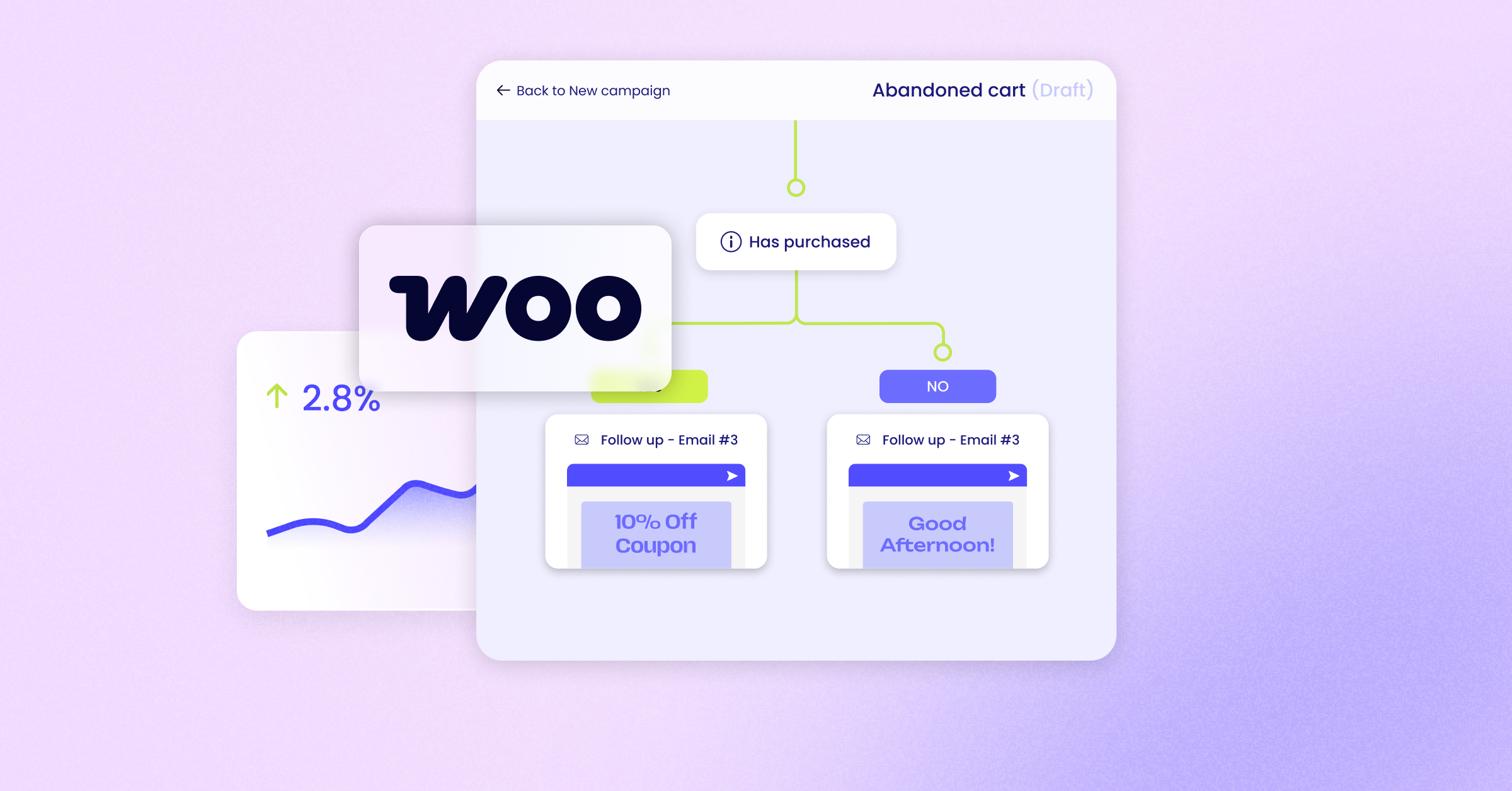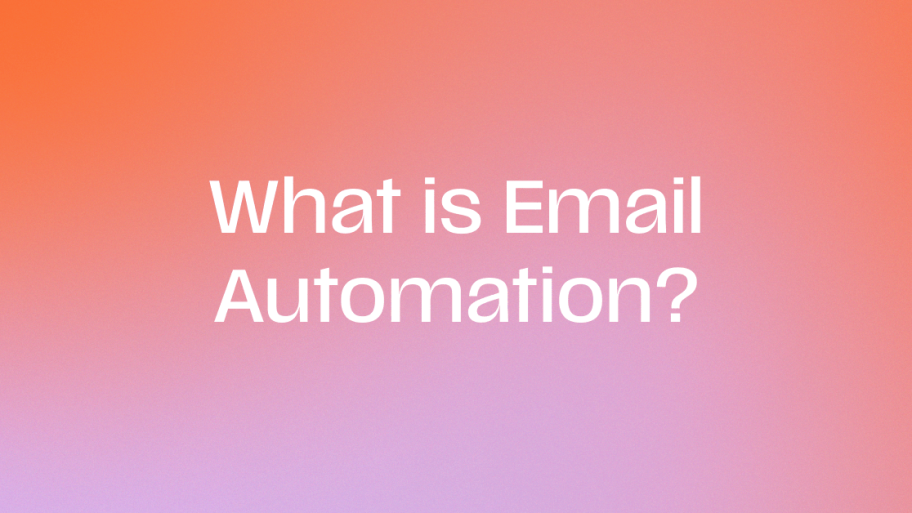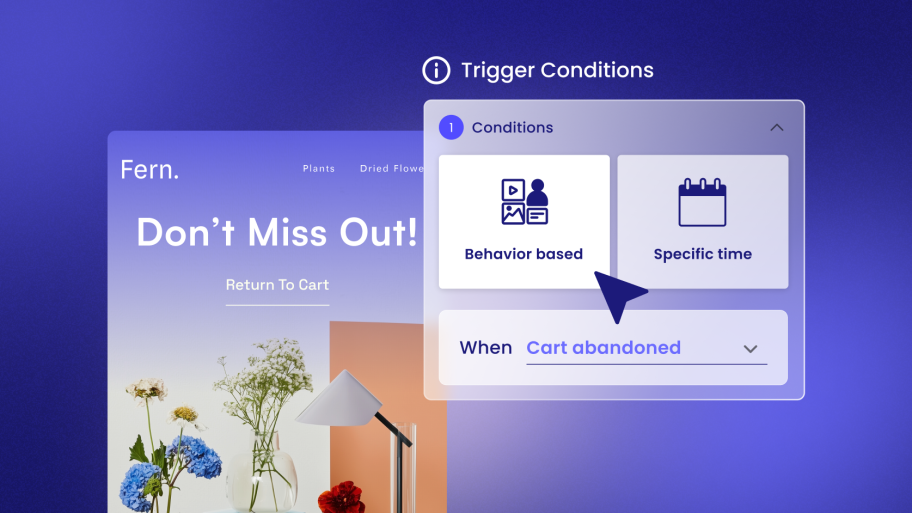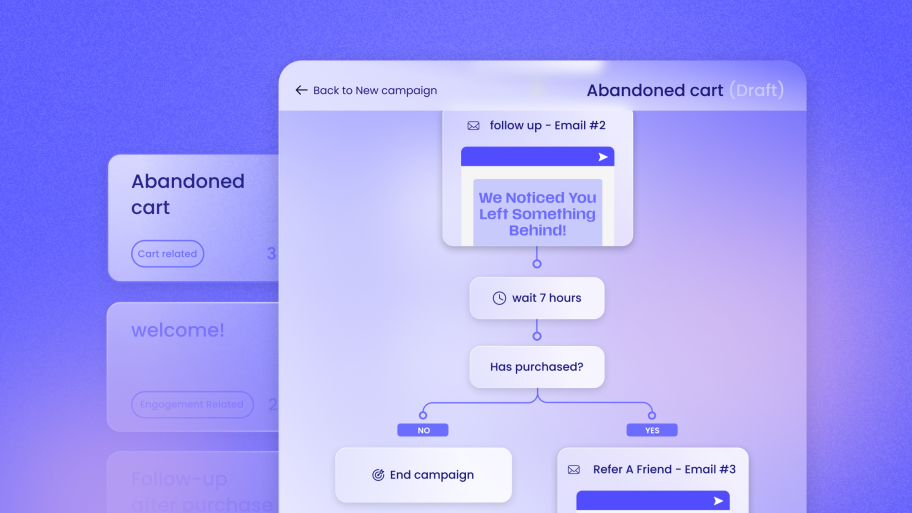This guide is here to provide clarity and direction. We’ve sifted through the noise to bring you a curated, in-depth look at the seven best email marketing platforms for WordPress in 2025. This isn’t just a list of features; it’s a strategic overview designed to help you understand the nuances of each platform.
Whether you’re a web creator looking to expand your client services into profitable new territory or a WooCommerce store owner seeking to increase revenue through targeted communication, this comprehensive guide will equip you to make a confident and informed decision. We’ll explore each platform’s core functionalities, pricing structures, and unique strengths, with a special focus on the most critical factor for WordPress users: seamless integration into the ecosystem you already know and trust.
The Landscape of WordPress and Email Marketing
WordPress powers a staggering 43.4% of all websites on the internet, a testament to its flexibility, scalability, and robust community. This dominance has cultivated a rich ecosystem of plugins and tools designed to extend its native functionality into virtually any area of business operations. Among these, email marketing solutions are essential for any serious online enterprise. With billions of active users globally, email remains a powerhouse for communication, consistently delivering a higher return on investment (ROI) than almost any other marketing channel.
For modern web creators and agencies, the job no longer ends when a website goes live. Clients are increasingly looking to their web professionals for strategic guidance on how to grow their businesses. Offering email and SMS marketing services has become a natural and lucrative extension of website development. It provides a clear path to generating recurring revenue and allows you to deliver tangible, ongoing value, strengthening client relationships long after the initial build is complete. The key to success lies in finding a solution that is both powerful for the client and remarkably simple for you to manage within the familiar WordPress environment.
This has become especially critical as businesses recognize the importance of owned marketing channels. An email list is an asset you control directly, unlike social media followings, which are subject to the platform’s algorithms and policies. Building this owned audience is a strategic imperative for long-term stability and growth.
What to Look for in a WordPress Email Marketing Platform
Before we dive into our top picks, let’s establish a clear framework for evaluation. The best platform for you will excel across these key criteria, ensuring it meets the unique demands of the WordPress environment.
- Seamless WordPress Integration: This is the most crucial factor. The platform should feel like a natural part of your WordPress dashboard, not a bolted-on component. This means an easy setup process, intuitive controls located within /wp-admin, and no need to switch between your website and an external platform constantly. Poor integration can lead to plugin conflicts, data synchronization errors, and a slower website—headaches that a truly native solution eliminates.
- Comprehensive Feature Set: Look for an all-in-one communication toolkit. The best platforms offer not just email campaign creation but also SMS marketing, sophisticated marketing automation, advanced audience segmentation, and detailed analytics. This consolidation eliminates the need for multiple, disconnected plugins to achieve your marketing goals.
- Ease of Use: An intuitive interface is non-negotiable. A drag-and-drop email builder, a library of professional templates, and pre-built automation flows (such as for abandoned carts) are essential for efficiency. You and your clients shouldn’t need to be coding experts or marketing gurus to create beautiful and effective campaigns. A familiar user experience that mirrors the WordPress or Elementor environment significantly lowers the learning curve.
- Deep WooCommerce Compatibility: For eCommerce stores, surface-level integration isn’t enough. You need deep compatibility with WooCommerce. This includes features like triggering emails based on purchase history, inserting dynamic coupon codes, providing product recommendations, and segmenting customers based on their lifetime value or purchase frequency.
- Scalable and Transparent Pricing: The pricing model should be clear, predictable, and able to grow with your business needs. Look for straightforward, usage-based models and be wary of platforms with complex fee structures, hidden costs for contact list management, or bizarre termination clauses. A generous free tier is also a major plus for new businesses.
- Support and Documentation: When you or a client runs into a problem, reliable support is invaluable. Check for accessible customer service options (like live chat or email support) and comprehensive documentation that can help you resolve issues quickly and independently.
With these criteria in mind, let’s explore the best email marketing platforms for WordPress in 2025.
1. Send by Elementor: The Ultimate WordPress-Native Toolkit
Send by Elementor stands apart from the pack because it was conceived and built with a singular focus: to be the ultimate WordPress-native communication toolkit. It isn’t an external platform with a connector plugin; it is a comprehensive solution that lives and breathes inside your WordPress dashboard. Designed to empower web creators, it bridges the gap between building a website and driving its success, enabling you to offer valuable, ongoing marketing services to your clients.
The core philosophy behind Send is the elimination of friction. By integrating email, SMS, automation, and analytics into a single, cohesive interface within WordPress, it eliminates the complexity and fragmentation that plague many marketing stacks. This seamless, integrated experience allows creators to manage every aspect of client communication without ever leaving the environment where they do their best work.
A Deep Dive into Native Integration
What does “truly WordPress-native” actually mean? It means Send is built for WordPress, not just connected to it.
- A Unified Dashboard: All your tools—contact management, campaign creation, automation flows, and analytics—are accessed directly within the WordPress /wp-admin area. There are no iframes loading external sites or constant prompts to log in elsewhere.
- Familiar UI: The user interface is designed to feel intuitive to anyone who uses WordPress or Elementor. This dramatically reduces the learning curve for you and your clients.
- Zero-Conflict Architecture: Because it’s built from the ground up for the WordPress environment, it’s engineered to avoid the common plugin conflicts and site slowdowns that can occur when trying to sync data with external services.
Comprehensive Feature Breakdown
Send by Elementor consolidates all the essential communication tools into a single, powerful platform:
- Email & SMS Marketing: Reach customers where they are most responsive, beyond email. You can design, send, and automate both email and SMS campaigns, creating a multi-channel strategy from one central hub.
- Marketing Automation Flows: This is where Send truly excels in driving business growth. You can utilize robust pre-built workflows for high-value scenarios like Abandoned Cart Recovery, Welcome Series for new subscribers, and Customer Re-engagement. For example, setting up an abandoned cart flow is effortless: the system automatically tracks when a logged-in user or known contact leaves a cart and sends a timed sequence of emails or texts to encourage them to complete the purchase. This single feature provides a direct and measurable ROI that you can easily showcase to your clients.
- Advanced Audience Segmentation: Effective marketing is targeted marketing. Send allows you to group contacts based on a rich set of criteria, including demographics, website behavior, and deep WooCommerce data. You can create segments for “customers who bought Product A but not Product B,” “VIP customers with a high lifetime value,” or “subscribers who haven’t opened an email in 90 days.” This precision ensures your messages are always relevant.
- Drag-and-Drop Email Builder: Reflecting the Elementor philosophy of visual design, the email builder is intuitive and powerful. You can create professional, fully responsive emails without touching a line of code, ensuring your designs look stunning in every inbox.
- Ready-Made Templates: Get a massive head start with a library of beautifully designed templates. These templates are based on Elementor’s design best practices and can be quickly customized to match your client’s brand.
- Real-Time, Demonstrable ROI: Send’s analytics are clear, real-time, and live right in your WordPress dashboard. You can track key performance indicators like open rates, click-through rates, and, most importantly, revenue attribution. This makes it incredibly simple to demonstrate the direct financial impact of your marketing efforts to clients.
A Toolkit for the Modern Web Creator
Send by Elementor is uniquely positioned to help freelancers and agencies evolve their business model. It transforms a one-time project service into a long-term, value-driven partnership.
- For Creators New to Marketing: If a client asks for “marketing stuff,” Send is the perfect entry point. You can start with a single, high-impact automation like Abandoned Cart. There are no complex APIs to manage or site slowdowns to worry about—just effective communication built right in.
- For Experienced Agencies: Stop juggling clunky, disconnected tools or outsourcing marketing. With Send, you can seamlessly integrate Email and SMS automation, sophisticated welcome flows, and powerful retention campaigns into your service offerings. You can manage multiple clients from within WordPress, prove your impact with clear analytics, and build highly profitable, long-term partnerships.
Pricing
Send by Elementor is expected to offer a fair, transparent, and usage-based pricing model that scales with your business. This approach, often including a generous free tier to get started, ensures that it’s an accessible and cost-effective option for businesses and agencies of all sizes.
2. MailPoet
MailPoet has earned its popularity in the WordPress community by adhering to a simple principle: keep it inside WordPress. It’s designed as a native plugin, allowing users to create, schedule, and send emails directly from their website’s backend. This makes it an attractive option for those who prioritize a unified dashboard and want to avoid relying on external services for their core email marketing.
How it Integrates with WordPress
Like Send by Elementor, MailPoet is a true WordPress plugin, not just a connector. The entire interface for designing emails, managing lists, and viewing reports is located within the /wp-admin dashboard. It can automatically import your WordPress user list, making it easy to start communicating with your existing members or customers right away.
Features
MailPoet provides a solid set of features for bloggers and small businesses. Its core offerings include:
- Email Builder: A drag-and-drop editor allows for the creation of responsive newsletters.
- Automation: You can set up automated emails, such as a welcome series for new subscribers or notifications to alert readers about new blog posts.
- WooCommerce Integration: MailPoet offers a dedicated integration for WooCommerce. This allows store owners to send automated emails to follow up on purchases, send recommendations, or target customers based on the products they’ve bought.
- List Management: You can manage your subscribers and segment them based on simple criteria, such as which list they signed up for or whether they have opened an email.
While powerful, its focus remains squarely on email, and it doesn’t offer the multi-channel communication options (like integrated SMS) that more comprehensive toolkits provide.
Pricing
MailPoet offers a generous free plan for sites with up to 1,000 subscribers, making it an excellent starting point for new websites and blogs. Paid plans are required for larger lists or for users who want to use MailPoet’s own reliable sending service, which improves deliverability.
3. HubSpot
HubSpot is a powerhouse in the marketing world, offering a vast, all-in-one platform that extends far beyond email. Its core strength lies in its Customer Relationship Management (CRM) system, which acts as the central hub for all customer interactions. The HubSpot WordPress plugin brings this functionality into your website, providing a suite of free tools for marketing, sales, and service.
How it Integrates with WordPress
The HubSpot plugin acts as a bridge to its powerful external platform. While it adds a menu to your WordPress dashboard for managing contacts, forms, live chat, and viewing analytics, the primary creation and management of email campaigns and complex automation happen within the main HubSpot web application. The integration is deep, automatically syncing data from WordPress forms and contacts into the HubSpot CRM.
Features
HubSpot’s offering is extensive, even on its free plan:
- Email Marketing: It includes a user-friendly drag-and-drop email builder and basic templates.
- CRM: Every contact and their interactions are logged in the free CRM, providing a holistic view of the customer journey.
- Marketing Tools: The plugin includes tools for creating forms, pop-ups, and implementing live chat and chatbots on your site.
- Automation: While basic automation is available, HubSpot’s more advanced and flexible workflow-building capabilities are a core part of its paid tiers.
The platform’s CRM-first approach means it’s an excellent choice for businesses focused on lead management and sales pipelines, but it can feel overly complex for users who just need a streamlined email and SMS communication tool.
Pricing
HubSpot is famous for its robust free plan, which includes the CRM, email marketing, forms, and more, albeit with HubSpot branding and some limitations on sending volume. Its paid plans, organized into “Marketing Hub” tiers, are significantly more expensive and are geared towards scaling businesses that need advanced automation and reporting.
4. Mailchimp
Mailchimp is one of the most recognized and widely used email marketing platforms globally. Its reputation is built on a user-friendly interface, strong brand identity, and a feature set that has historically served small businesses and startups well. Its integration with WordPress is primarily managed through various third-party plugins, the most popular being “MC4WP: Mailchimp for WordPress.”
How it Integrates with WordPress
The MC4WP plugin is a connector. Its primary function is to make it easy to create and add Mailchimp sign-up forms to your WordPress site. It seamlessly syncs new subscribers from your website to your lists within the Mailchimp platform. However, all campaign creation, automation management, and reporting take place on Mailchimp’s external website. It does not provide a native, in-dashboard experience for managing your marketing efforts.
Features
Mailchimp’s platform offers a well-rounded set of tools:
- Email Editor: An intuitive drag-and-drop builder is at the core of the Mailchimp experience, supported by a wide variety of templates.
- Basic Automation: The platform offers simple automation capabilities, such as single welcome emails. More complex, multi-step workflows are reserved for paid plans.
- Audience Management: Mailchimp provides tools for list segmentation and contact tagging.
- Reporting: You get clear reports on campaign performance, including open rates, click rates, and audience growth.
Pricing
Mailchimp offers a free plan that allows for up to 500 contacts and a limited number of email sends per month. This makes it an accessible option for those just starting. As your list and sending needs grow, you will need to upgrade to one of their paid plans, which are tiered based on features and contact count.
5. Brevo (formerly Sendinblue)
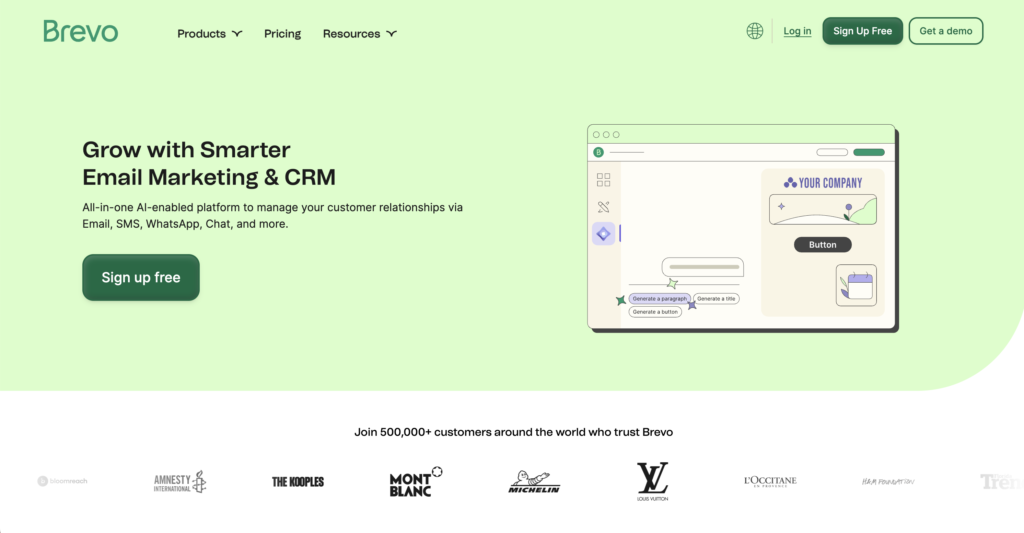
Brevo has carved out a niche for itself by positioning its platform as an affordable, all-in-one marketing and sales solution. It offers a broad suite of tools that includes email marketing, SMS marketing, live chat, a CRM, landing pages, and more. Its official WordPress plugin allows you to manage many of these functions from within your site.
How it Integrates with WordPress
The Brevo WordPress plugin syncs your contacts and allows you to create forms, manage transactional emails, and view basic statistics from your dashboard. While some management is possible from within WordPress, the leading campaign builders and automation workflows are hosted on the external Brevo platform. The integration focuses on efficiently transferring data from your site into their system.
Features
Brevo’s main draw is the sheer breadth of its features, even at low price points:
- Multi-Channel Communication: It natively supports email, SMS, and WhatsApp campaigns.
- Marketing Automation: Brevo provides a powerful automation editor that allows you to build workflows based on user behavior, such as page visits or email engagement.
- Transactional Emails: One of its standout features is a reliable and highly affordable SMTP service for sending transactional emails (like order confirmations and password resets), which is a huge benefit for WooCommerce stores and membership sites.
- Sales & Service Tools: The platform also includes a sales CRM, landing page builder, and a shared inbox for team-based customer support.
Pricing
Brevo is known for its competitive pricing. It offers a free plan that includes up to 300 email sends per day and access to its core features. Its paid plans are generally more affordable than many competitors, making it a strong contender for budget-conscious businesses needing a wide range of tools.
6. Constant Contact
Constant Contact is one of the original players in the email marketing industry, with a long history of serving small businesses. It has built its brand on being easy to use and providing excellent customer support, including real-person phone support —a rarity in the field.
How it Integrates with WordPress
Integration with WordPress is handled via an official plugin. The primary function of the plugin is to allow for the easy creation and embedding of Constant Contact sign-up forms on your WordPress site. It helps you capture leads and grow your email list, which is then managed entirely on the Constant Contact external platform. All email creation, sending, and analytics happen outside of the WordPress dashboard.
Features
Constant Contact focuses on providing a straightforward and effective email marketing experience:
- Email Editor: It features a user-friendly drag-and-drop editor and a large library of mobile-responsive templates to help users get started quickly.
- Social Media Tools: The platform includes tools for creating social media posts and ads directly from your Constant Contact account.
- Basic Automation: It offers simple autoresponders, such as welcome emails for new subscribers and anniversary or birthday messages.
- Event Marketing: It has specialized tools for managing event invitations, registrations, and follow-ups.
Pricing
Constant Contact does not have a free-forever plan, which sets it apart from many others on this list. It does, however, offer a lengthy free trial. Its pricing is tiered based on the number of contacts in your list, with more advanced features like automation and segmentation included in the higher-priced plans.
7. AWeber
AWeber is another well-established email marketing service that has been trusted by businesses for over two decades. It has a strong reputation for excellent email deliverability and provides a comprehensive set of tools designed to help users grow their audience and sales.
How it Integrates with WordPress
AWeber integrates with WordPress through various methods, including an official plugin and native integrations with page builders like Elementor. These integrations allow you to add AWeber sign-up forms to your website easily, so any new subscriber is automatically added to your list. Similar to Mailchimp and Constant Contact, the core platform—where you design emails, create automations, and analyze results—is hosted externally.
Features
AWeber provides a robust set of tools tailored for email-centric marketing:
- AI-Powered Design: It features a Smart Designer tool that can automatically create branded email templates from your website’s URL.
- Email & Landing Page Builder: In addition to a drag-and-drop email editor, it also includes a landing page builder to create simple campaign pages.
- Automation: The platform includes automation capabilities that allow you to create automated email sequences based on triggers like a new subscription or a tag being added to a contact.
- Web Push Notifications: AWeber offers web push notifications as an additional channel to engage with your audience.
Pricing
AWeber offers a completely free plan for up to 500 subscribers, which includes access to most of its core features, including automation and landing pages. This makes it a very attractive option for new businesses. Paid plans unlock higher subscriber limits, more detailed analytics, and advanced segmentation.
Making Your Decision: Integration is Key
Selecting the best email marketing platform for your WordPress site is a strategic choice that hinges on your unique business needs, your clients’ goals, and your preferred workflow.
| Platform | Native to WordPress? | Core Focus | Best For |
| Send by Elementor | Yes, truly native | All-in-one communication toolkit | Web creators & agencies wanting a seamless, integrated workflow to offer recurring services. |
| MailPoet | Yes, truly native | Email marketing & newsletters | Bloggers and small businesses who want to manage everything inside WordPress. |
| HubSpot | No (connector plugin) | CRM & Inbound Marketing | Businesses focused on sales pipelines and lead management needing an all-in-one suite. |
| Mailchimp | No (connector plugin) | Email marketing | Startups and users who value brand recognition and a simple external interface. |
| Brevo | No (connector plugin) | Multi-channel marketing on a budget | Budget-conscious businesses needing a wide array of tools, including transactional email. |
| Constant Contact | No (connector plugin) | Simple email marketing | Small businesses who value ease of use and strong, hands-on customer support. |
| AWeber | No (connector plugin) | Email marketing & automation | Users looking for a feature-rich free plan and strong deliverability. |
For web creators and agencies, the decision often comes down to efficiency and opportunity. A truly WordPress-native platform like Send by Elementor presents a clear advantage. Its seamless integration, combined with a comprehensive toolkit for email, SMS, and automation, empowers you to offer sophisticated marketing services without the inherent complexity of managing disconnected systems. This streamlined workflow enables you to establish stronger, long-term client relationships built on demonstrable results and ongoing, recurring value.
For individual business owners and WooCommerce stores, the choice may be driven more by specific features or budget. While platforms like HubSpot offer an unparalleled CRM and Brevo provides incredible value, it is crucial to consider the hidden cost of complexity and a fragmented user experience.
Ultimately, the modern digital landscape demands more than just a website; it requires an integrated communication strategy. The platforms outlined above all provide powerful tools to build that strategy. Take the time to evaluate each option against your specific goals. Consider not just where your business is today, but where you want it to be tomorrow. By choosing a platform purpose-built for your ecosystem and that can grow with you, you are making a profound investment in the long-term success of your online presence.
